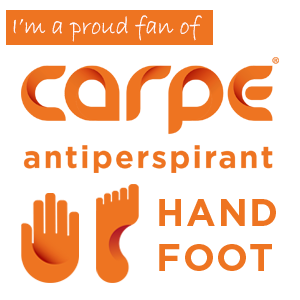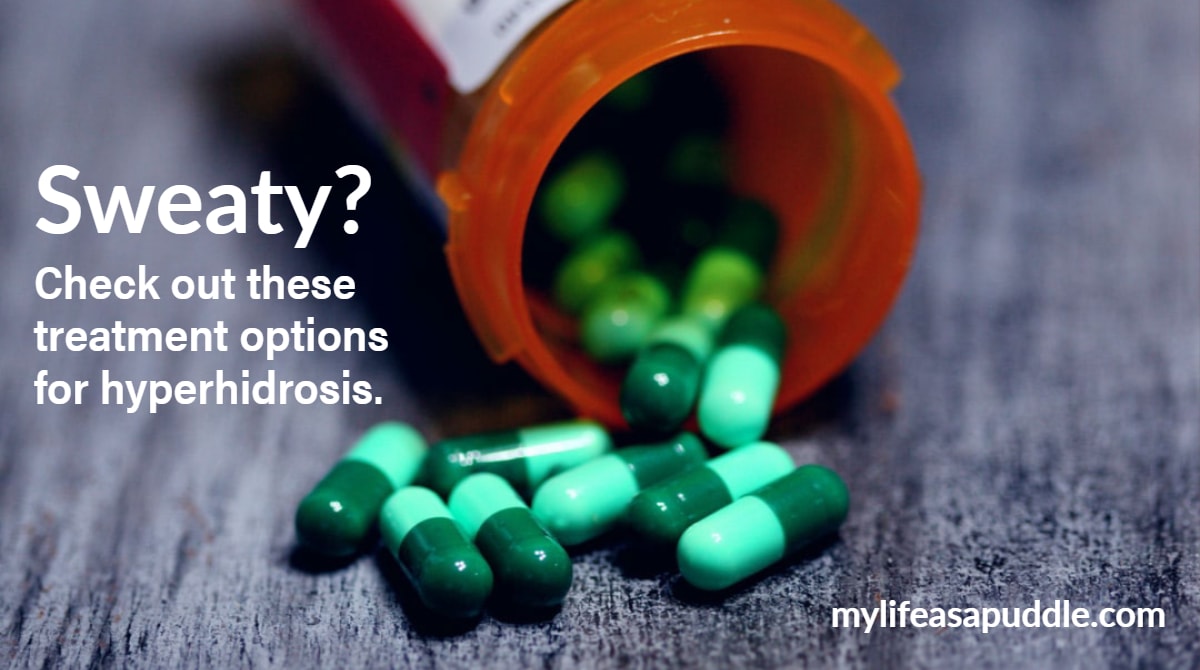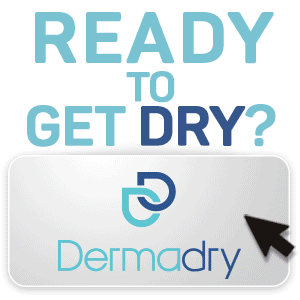Updated October 1, 2023
While there isn’t a cure yet for hyperhidrosis, there are many treatment options for excessive sweating that are available over the counter, via prescription, or in a healthcare provider’s office.
Hyperhidrosis Defined
If you’re new to my blog, let’s start at square one.
Perhaps you’ve never heard the term hyperhidrosis before. If you have excessive, uncontrollable sweating (four to five times more perspiration than the average person who sweats), you might have hyperhidrosis.
Hyperhidrosis is a recognized medical condition that can cause a crapload of problems for those who have to live with it, including skin infections, social anxiety, and depression. It’s more than just a physical problem on your skin.
Now that we’ve got the definition out of the way, let’s chat about how we get this horrible problem to stop, even if only temporarily.
Treatments for Hyperhidrosis
Picture the following list of treatments like a pyramid, with the most common, least invasive or least complicated at the bottom, and the more involved procedures at the top.
Antiperspirants
What’s the difference between an antiperspirant and a deodorant?
Antiperspirants do just what they sound like – they are anti-sweat and work by creating plugs in the pores of the skin to block the sweat from escaping. Apply these at night to clean skin for maximum effectiveness. Since your body temperature cools overnight, it allows your pores to better absorb the ingredients to form those plugs.
Deodorant simply blocks odor.
Over-the-Counter Antiperspirants
Look for the words clinical strength on products for the highest percentage of active antiperspirant ingredients. Or, look on the packaging under ingredients to manually determine the percentage of active ingredient.
There are many OTC products for hyperhidrosis, including creams, lotions, powders and wipes.
I’ve had good results with Carpe products for excessive sweating.
Note: I am a brand partner for Carpe, and this is an affiliate link. Your purchase earns me credit for any sales made through this link, which helps me pay for the costs associated with running my website. Thank you for your support!

Carpe lotion is available over the counter to treat hyperhidrosis.
OTC antiperspirants aren’t just for your underarms. If you have groin sweating, for example, you can try sensitive skin and unscented varieties for that sensitive area. I don’t recommend applying it directly onto your private parts, but around the general area instead.
Prescription Antiperspirants
The most common active ingredient is aluminum chloride hexahydrate; many brand names are available. Follow the directions from your health care provider, pharmacist, or the package insert as these medications can be more harsh on the skin.
Natural Remedies
These might include sage tablets, St. John’s Wort, valerian root, chamomile and others. While there aren’t many studies on these herbs, we shouldn’t discount their potential effectiveness. Each person’s body is different, so some of these might work to help you find relief from hyperhidrosis.
Oral Medications for Excessive Sweating
Anticholinergics
Prescribed as an off-label use for hyperhidrosis, this class of medications hasn’t been studied in clinical trials for hyperhidrosis. However, these medications have been to shown to be effective in decreasing sweating. Anticholinergics work by blocking the neurotransmitter acetylcholine, the little jerk that precipitates the nerve impulse that creates sweating. Generic names include glycopyrrolate, oxybutynin, benztropine, propantheline, etc.
Beta Blockers
Beta blockers like propranolol or metoprolol work in the central nervous system by blocking the body’s physical reaction to anxiety. Many people will take a beta blocker before public speaking engagements to help them calm down. These medications are typically for short-term, episodic instances of hyperhidrosis, like sweaty job interviews. Many cannot tolerate their long-term side effects.
Benzodiazepines
These are controlled substances prescribed for those with anxiety. Use with caution; this class of medication can have an addictive effect. Not everyone with hyperhidrosis has anxiety, but hyperhidrosis can cause it.
In some people, we’re not sweating because we’re nervous, we’re nervous BECAUSE we’re sweating. There is a difference.
Botox®
OnabotulinumtoxinA injections (Botox®) block the chemical that is responsible for turning on the body’s sweat glands, at least temporarily. I’ve had these injections in my hands, which you can read about here.
Iontophoresis
This is a medical device that uses an electrical current passed though shallow water, which temporarily blocks the sweating. Iontophoresis is generally used for hands and feet by placing them in shallow trays filled with water that contain metal boards to conduct the electricity. Most companies require a prescription in order to ship the machine.
Lasers
Used to treat axillary hyperhidrosis (sweaty underarms), lasers can precisely target, treat and destroy sweat glands in this area.
miraDry®
miraDry® uses microwave technology to elimate sweat and odor glands in the underarms. It’s available in over 50 countries worldwide.
Qbrexza™
The prescription medication is a cloth containing glycopyrronium and is an anticholinergic. It’s applied topically to the underarms to reduce axillary hyperhidrosis.
Brella™ SweatControl Patch™
Approved by the U.S. FDA in April 2023, this patch treats excessive underarm sweating, also known as axillary hyperhidrosis. Read more about Brella for sweaty pits.
Surgeries for Hyperhidrosis
Local Surgery for Underarms
This is called local because the surgery is performed locally on the area affected by excessive sweating, which is the underarms. Surgery is used to remove the sweat glands; they may be cut, scraped or suctioned out.
ETS Surgery
This is the most drastic and permanent procedure to treat hyperhidrosis, and many consider it a last resort.
Please make sure you do your research before committing to this procedure. Don’t simply trust the results you see on the first page of your internet search.
Many of those first page search results could be paid advertisements by those who perform this procedure.
ETS stands for endoscopic thoracic sympathectomy. This is where a surgeon severs individual nerves on the sympathetic nervous chain near the spinal column. ETS is a permanent procedure, and no successful reversals have been reported.
I’ve met people in person who are literally sweating through two layers of clothes due to compensatory sweating (CS) from ETS surgery. They deeply regret having the surgery, and their CS is worse than the original sweating they were trying to stop.
Read Carrie’s ETS story and Leann’s ETS story.
For a complete explanation of ETS surgery, visit the International Hyperhidrosis Society.
Mental Health and Hyperhidrosis
While these may not treat your hyperhidrosis, they can help improve your mental health and well-being and/or produce a feeling of relaxation. I’ve done or continue to do all of these myself.
Related: Watch my video interview on hyperhidrosis and mental health with psychoanalyst Dr. Claudia Luiz.
Therapy
I love therapy! Find a good psychologist or licensed family therapist to help you dig deep into your hyperhidrosis feelings if you need to. Sometimes a therapist can help you discover underlying causes or thought patterns that are responsible for how you might feel.
Consult a psychiatrist or your primary care physician if you are experiencing symptoms of depression or anxiety. In some cases, medications like antidepressants may help you. Be aware, though, that some antidepressants can actually increase sweating as a side effect.
Massage
But I can’t let anyone touch me! I’ve heard that BS excuse before, because it’s one I used myself. Here’s how I got over it to accept the gift of touch.
Pedicures
My feet sweat wayyyy too much to go through with this. Also a BS excuse I used to use. Here’s how I let my sweaty feet be exposed.
Acupuncture
While acupuncture to treat hyperhidrosis didn’t work for me, the overall body benefits and relaxation did help me feel better as a person. Read my sweaty acupuncture stories.
Final Thoughts on Hyperhidrosis Treatments
I hope you find this information useful. While there currently isn’t a cure for hyperhidrosis, this is a pretty comprehensive list of options to try. Remember, each person’s body is different. What works for one may not work for another.
I am thankful we have a variety of treatment options from which to choose, and I will never give up hope that one day hyperhidrosis can be cured. Because without hope, we have nothing.
Sources:
- International Hyperhidrosis Society. Hyperhidrosis Treatment Overview. Retrieved from https://sweathelp.org/hyperhidrosis-treatments/treatment-overview.html on Nov. 15, 2019
- Mayo Clinic. Hyperhidrosis Diagnosis & Treatment. Retrieved from https://www.mayoclinic.org/diseases-conditions/hyperhidrosis/diagnosis-treatment/drc-20367173 on Nov. 15, 2019
- Miradry. How it works. Retrieved from https://www.miradry.com/how-it-works/ on Nov. 15, 2019







